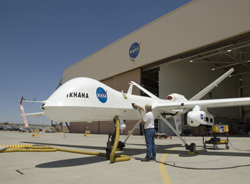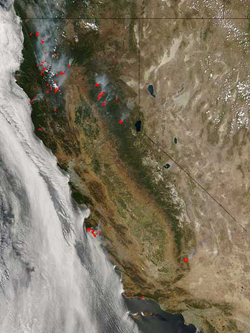In response to the ongoing fires in California, NASA continues to support the U.S. Department of Agriculture Forest Service and the State of California.
California Governor Schwarzenegger’s Office of Emergency Services contacted NASA Ames Research Center requesting to use Ikhana, the NASA Predator-B unmanned aircraft, to obtain visible light, infrared and thermal imagery of the California wildfires. Last year, the imagery provided by Ikhana was able to complement the other tools used by emergency response personnel to effectively allow them to see through the smoke of the 2007 wild fires to monitor and predict the fire’s behavior.
 The remotely piloted aircraft is carrying the NASA-developed Autonomous Modular Scanner on several planned flights. Originating at NASA’s Dryden Flight Research Center, the flights are covering an area from Santa Barbara to the Oregon border. The sensor, its telemetry and real-time data processing were developed by NASA Ames. The sensor, carried in an external pod under the aircraft’s wing, detects temperature differences from less than one-half degree to approximately 1,000 degrees Fahrenheit, revealing fire hotspots.
The remotely piloted aircraft is carrying the NASA-developed Autonomous Modular Scanner on several planned flights. Originating at NASA’s Dryden Flight Research Center, the flights are covering an area from Santa Barbara to the Oregon border. The sensor, its telemetry and real-time data processing were developed by NASA Ames. The sensor, carried in an external pod under the aircraft’s wing, detects temperature differences from less than one-half degree to approximately 1,000 degrees Fahrenheit, revealing fire hotspots.
In Ikhana’s first flight on July 8, the aircraft flew over 10 individual or complex fires along a route over the Sierra Nevadas, west to the Cub Complex fire in Northern California and south to the Gap Fire in Santa Barbara County. Currently there are more than 300 wildfires burning in the state.
 Once the images are collected onboard Ikhana, they are then transmitted through a communications satellite to NASA Ames where the imagery is superimposed over ground maps to better visualize the location and scope of the fires.
Once the images are collected onboard Ikhana, they are then transmitted through a communications satellite to NASA Ames where the imagery is superimposed over ground maps to better visualize the location and scope of the fires.
From a ground control center, NASA pilots command the Ikhana aircraft in close coordination with the Federal Aviation Administration, which is allowing the aircraft to fly within the national airspace while maintaining safe separation from other aircraft. The imagery is then transmitted to the Multi-Agency Coordination Center in Redding, California, and the State Operations Center in Sacramento, within minutes of acquisition, which distributes it to incident commanders in the field.
The Science Mission Directorate funded development of the fire sensor with the intention of having the capabilities transition to operational agencies in the near future. By transitioning this technology to operational agencies the benefits of this research and development effort can support the entire national wildfire fighting efforts.
More images are at: https://www.nasa.gov/topics/earth/features/fire_and_smoke.html
